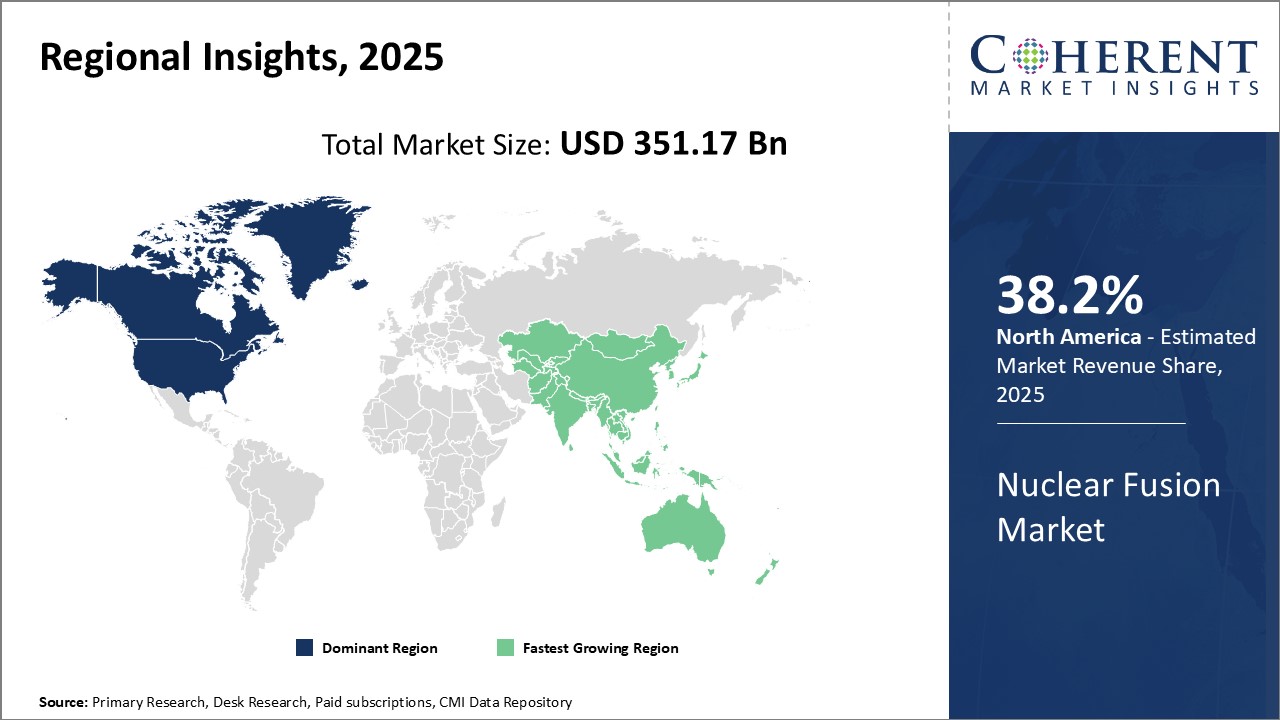Global Nuclear Fusion Market is estimated to be valued at USD 351.17 Bn in 2025 and is expected to reach USD 528.38 Bn by 2032, growing at a compound annual growth rate (CAGR) of 6.0% from 2025 to 2032.
| Report Coverage |
Report Details |
| Base Year: |
2024 |
Market Size in 2025: |
USD 351.17 Bn |
| Historical Data for: |
2020 To 2024 |
Forecast Period: |
2025 To 2032 |
| Forecast Period 2025 to 2032 CAGR: |
6.00% |
2032 Value Projection: |
USD 528.38 Bn |
Figure. Nuclear Fusion Market Share (%), By Region 2025

Nuclear fusion is an incredibly complex process that involves heating hydrogen plasma to nearly 100 million degrees Celsius so that atomic nuclei fuse together and release massive amounts of energy. The potential to harness fusion as a nearly limitless source of clean energy has long captured the imagination of scientists and engineers. While current fusion research facilities can achieve fusion reactions on a very small scale, producing useful net energy from fusion continues to present major technological challenges that researchers worldwide are working to solve. Progress is being made on developing new materials able to withstand extreme heat and radiation, advancing plasma physics understanding, and designing next-generation fusion machines such as tokamaks and stellarators that can produce self-sustaining 'burning plasmas'. If these challenges can be overcome, fusion power plants may one day provide humanity with abundant, sustainable low-carbon energy for centuries to come without many of the disadvantages of current power sources.
Market Dynamics:
The global nuclear fusion market growth is driven by several factors such as growing focus on developing viable clean energy solutions, increasing energy demand worldwide, and high costs associated with fossil fuels. However, developing economic fusion power poses substantial technical barriers such as achieving net energy gain from fusion reactions and designing robust materials able to withstand harsh fusion conditions. Significant investments totaling billions of dollars by governments and private organizations in Asia, Europe, and North America into experimental fusion facilities such as ITER and NIF are helping to expand scientific knowledge in plasma physics and overcome key technological hurdles. Meanwhile, the market faces uncertainties from potential project delays or cost overruns. On the other hand, the successful demonstration of commercial fusion power could present lucrative business opportunities. New startups are exploring alternative fusion approaches like inertial electrostatic confinement that may help accelerate progress. If technical issues are addressed, fusion energy may play a meaningful role in future global energy portfolios.
Key Features of the Study:
- This report provides an in-depth analysis of the global nuclear fusion market, and provides market size (US$ Bn) and compound annual growth rate (CAGR%) for the forecast period (2025-2032), considering 2024 as the base year.
- It elucidates potential revenue opportunities across different segments and explains attractive investment proposition matrices for this market.
- This study also provides key insights about market drivers, restraints, opportunities, new product launches or approval, market trends, regional outlook, and competitive strategies adopted by key players.
- It profiles key players in the global nuclear fusion market based on the following parameters company highlights, products portfolio, key highlights, financial performance, and strategies.
- Key companies covered as a part of this study include Zap Energy, First Light Fusion, General Fusion, TAE Technologies, Commonwealth Fusion, Tokamak Energy, Lockheed Martin, Hyperjet Fusion, Marvel Fusion, Helion, HB11, Agni Fusion Energy, Southern Company, First Light Fusion Ltd, Brilliant Light Power Inc, Marvel Fusion GmbH, and HB11 Energy.
- Insights from this report would allow marketers and the management authorities of the companies to make informed decisions regarding their future product launches, type up-gradation, market expansion, and marketing tactics.
- The global nuclear fusion market report caters to various stakeholders in this industry including investors, suppliers, product manufacturers, distributors, new entrants, and financial analysts.
- Stakeholders would have ease in decision-making through various strategy matrices used in analyzing the global nuclear fusion market.
Market Segmentation
- Technology:
- Inertial Confinement
- Magnetic Confinement
- Others
- Fuels:
- Deuterium/tritium
- Deuterium
- Deuterium, helium-3
- Proton Boron
- Others
- Regional:
- North America
- Europe
- Asia Pacific
- Latin America
- Middle East & Africa
- Company Profiles:
- Zap Energy
- First Light Fusion
- General Fusion
- TAE Technologies
- Commonwealth Fusion
- Tokamak Energy
- Lockheed Martin
- Hyperjet Fusion
- Marvel Fusion
- Helion
- HB11
- Agni Fusion Energy
- Southern Company
- First Light Fusion Ltd
- Brilliant Light Power Inc
- Marvel Fusion GmbH
- HB11 Energy






